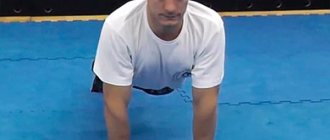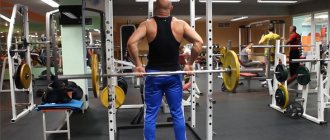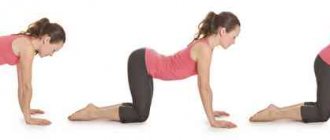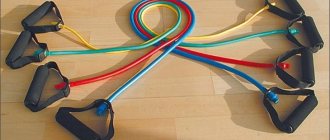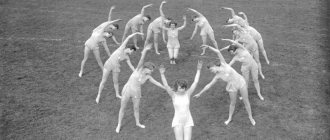There is very little information on powerlifting training on the Internet. Everything that is there is designed for athletes with extensive theoretical training, who understand weightlifting terms and know how to correctly describe cycles.
In this article, we'll look at what powerlifting accessory exercises and whether they should be included in your training program.
Attention! Before you start studying the exercises, understand their classification. Be able to distinguish between general preparatory and special preparatory.
Classification of exercises in powerlifting
Classification of exercises in powerlifting (Boris Sheiko model)
Powerlifting exercises are divided into two groups:
- Basic: competitive and special-preparatory. They are the foundation of your training.
- Additional: general training - improves the physical qualities of the athlete. Exercises for individual muscle groups with various apparatus (horizontal bar, parallel bars). This also includes running, swimming and sports games. They indirectly influence the results in competitive exercises and serve to diversify the training process.
Basic exercises are divided into two subgroups:
| Classification of basic exercises in powerlifting | ||
| Competitive | Directly squats with a barbell, bench press and deadlift. | |
| Special preparatory | Improves the technique and physical qualities of an athlete in competitive movements. | |
Basic exercises are used to create the “foundation” of an athlete. And additional ones are for comprehensive development.
General preparatory and special preparatory exercises are usually called auxiliary (auxiliary).
What is it for:
1. Muscles will grow more or less evenly. Since basic movements are the most anatomically natural for the body, due to joint work, which is regulated by reflexes, the body itself will not allow something to be “pumped” and another muscle group to lag behind in development.
2. The progress of strength in basic exercises is due to the synergistic effect when the joint effort of the muscles turns out to be greater than the simple arithmetic sum of the efforts of each muscle separately. The mutual strengthening of all muscles quickly increases the weight of the projectile with which the athlete is able to work. Well, as training weights increase, mass also increases, since its increase is the body’s protective reaction to increased loads.
3. The coordinated work of many muscles more reliably protects the athlete from injury than when using isolated exercises, since the work includes not only the target muscles that actually move the projectile along a given trajectory, but also the so-called stabilizer muscles. From their name it is clear that their task is to stabilize the projectile, i.e. to prevent any sharp fluctuations and deviations from the trajectory, which most often cause injuries. This, by the way, is a significant argument in favor of using the “base” in the initial stages of training for beginners.
4. The involvement of a large number of muscle groups in the work is accompanied by large energy consumption of the body. And with proper nutrition, the use of BCAAs and kartinin, energy will be obtained from the “melting” of fats. That is, the “base” promotes weight loss!
5. The work of increasing muscle mass with basic exercises is also significantly reduced in terms of the fact that they relieve the athlete from the need to gruelingly work out one muscle group with a large number of approaches. Another important point is that while taking on part of the load, other muscles help the target group receive additional load. Paradox? How is it that while removing the load, they simultaneously increase it? To understand, let’s look at a simple example of a biceps curl performed using an isolated technique (with elbows supported). Let's say you can lift 50 kg this way. in 8 repetitions. After this, you don’t have the strength to bend your arms and you either stop the approach or reduce the weight. Using the basic principle of cheating, you push your biceps past the sticking point with leg strength and core movement, and then lift the weight further with your arms. As a result, you can do several more repetitions with the same weight. Basic exercises work the same way.
6. Another advantage is not obvious from the outside, but has a very significant impact on the progress of training in general: according to medical research, when performing basic exercises, the body releases an increased amount of growth hormones and testosterone into the blood. That is, basic exercises are natural anabolics!
None of the serious athletes grow mass with isolated exercises. What are they for, you ask? They also have their useful uses. For example, they allow you to “finish off” a muscle group that you train in training after you have performed one or two basic movements on it. Moreover, “finishing off” is no longer in general, but purposefully some specific lagging bundle. Isolated movements are also used when working on relief and form during the period of preparation for bodybuilding tournaments, when the total mass is no longer important, but it is necessary to work on the appearance of the muscles. And of course, athletes use isolated movements to rehabilitate injuries. However, let's return to the main topic of basic exercises.
In powerlifting, unlike bodybuilding, perhaps the only use of isolation movements is recovery from injury. There is no place for them in other qualities in lifting training. This is due to the fact that for a powerlifter, the shape of the muscles and which muscle bundle creates an imbalance with the neighboring one a couple of centimeters is not important. The main goal of powerlifting is to develop extreme strength, and as you can see from the list of benefits above, the compound movements are the best way to achieve this goal. After all, lifters even compete in the three “most basic” of all basic movements: the squat, deadlift and bench press.
So, if you are a beginner athlete and have decided to connect your future career with powerlifting, then you should not even have any doubts about which exercises to master first: of course, the “basic”.
Well, now let's look at the best basic exercises for various muscle groups.
How to choose auxiliary exercises?
Special preparatory exercises are selected individually, based on the athlete’s weaknesses and depend on the training period. However, novice athletes do not know their weaknesses in competitive exercises, so 2-3 general preparatory exercises can be included in the training.
We have prepared special materials that contain a list of special preparatory exercises for bench presses, squats and deadlifts:
Access is temporarily closed. Contact the site administration.
Bench Press Assistance Exercises Squat Assistance Exercises Deadlift Assistance Exercises
Do you need to do assistance exercises?
Do you need to do assistance exercises?
If you are an athlete and know your weaknesses in competitive exercises, then perform special preparatory exercises according to our recommendations in the last section.
For general development, beginners can perform general preparatory exercises at the end of the workout. For example, bent over rows, standing dumbbell presses, lunges. All these exercises will help diversify your workout and increase muscle tone.
https://youtu.be/zm1gzL8uBQg
Basic mistakes in auxiliary exercises
Mistake 1 - a large number of auxiliary exercises
Perform at least 6 accessory exercises on different muscle groups to work your entire body.
There should be no more than 3 auxiliary exercises per workout, since your main goal is progress in competitive exercises.
Mistake 2 - striving for maximum progress in general preparatory exercises
Try to increase the working weight from workout to workout.
Perform general preparatory exercises with a standard load: 3 sets of 8-12 repetitions. And gradually increase the weight, but don’t try to do it every workout. Your main task is to progress in competition.
Mistake 3: Doing auxiliary exercises to failure
At each workout, complete the auxiliary requirement.
It happens that after a high-volume workout (many sets and repetitions), there is no strength left to perform auxiliary exercises. This is a completely normal situation, so if you feel tired, do not perform accessory exercises or reduce the working weight in them by half.
Bench Press Assistance Exercises
Now let's talk about auxiliary exercises for the power bench press, which will help you improve your performance in this exercise.
Bench press, close grip
This exercise allows you to develop the anterior deltas, as well as triceps. It is recommended to perform 2 to 8 repetitions in 3 to 5 sets.
Incline Bench Press
With this exercise you can develop your triceps and anterior deltoids. Watch your grip, it should not be very wide. It is recommended to perform 3 to 5 sets of 2–8 repetitions each.
Bench press in a sitting position from the chest, medium or wide grip
This exercise will help develop the anterior deltas. To perform the exercise, you should use an incline bench. At a small angle of inclination, the risk of injury is significantly reduced. This is due to the fact that the shoulder joints will be in a more natural position. In total, you should perform from 3 to 5 approaches, consisting of 3–8 repetitions.
Dips
A very popular exercise, which confirms its effectiveness in training the triceps, anterior deltoids and lower chest. When performing the movement, the amplitude should not be very large and correspond to the amplitude of the bench press in a lying position with an average grip. If the amplitude is large enough, the risk of injury to the elbow joints increases. The number of approaches is unchanged in comparison with previous exercises and ranges from 3 to 5 with 3–8 repetitions in each.
Dumbbell fly-press using a horizontal bench
The exercise is aimed at pumping the middle and lower sections of the chest. The movement should be performed as quickly as possible. The number of recommended reps and reps remains the same as the previous exercises.
It should also be noted that the seated barbell press, dips and dumbbell fly-presses are the main auxiliary movements and should be performed at least once a week each.
French press using an incline bench
This exercise helps develop the lower triceps. When performing a movement, you must remember about its high risk of injury. When using large working weights, you can get a chronic injury to your elbow joints. The exercise should be performed from 3 to 5 sets of 5–8 repetitions.
Arm extension on a vertical block
This movement will help you strengthen your triceps. The number of approaches and repetitions remains the same compared to previous exercises.
Pressing the barbell from a dead point
This exercise eliminates one of the possible bottlenecks when performing the bench press. The amplitude of its execution should be chosen based on at what point in the athlete’s trajectory the problems begin.
Bench press with a maximally arched back
Thanks to this exercise, you can discover the trajectory of maximum favorability. The movement is performed as follows: the legs and trapezius rest against the bench, the back is arched as much as possible, and the amplitude of the exercise is minimal. The number of approaches can be from 3 to 6 with 2-5 repetitions.
Swing dumbbells forward
The anterior section of the delta is being worked on. When performing the exercise, you must use only muscle strength, without using cheating techniques. The hand is somewhat relaxed.
Using all the auxiliary exercises listed above for the power bench press, the athlete can significantly improve his results in this powerlifting discipline.
You can visually familiarize yourself with the technique of performing auxiliary exercises to improve bench press performance in this video tutorial:
https://youtu.be/zoAco9hArQ4
Auxiliary exercises using the example of the Russian cycle
We advise beginners to study according to the Russian cycle. This is a simple training program that automatically calculates the working weights, approaches and repetitions.
Article about the Russian cycle
Is it necessary to perform auxiliary exercises in the Russian cycle? General preparatory ones are optional, but you can add them for variety. If you have weaknesses in the exercises, follow our recommendations.
At weeks 4-9 of the cycle, you need to reduce the working weight in the auxiliary exercises in order to concentrate on increasing the results in the competition ones.
Energy savings when removing the bar
To perform a high-quality squat in powerlifting, it is necessary to maximally develop the muscles of the back and legs and follow the rules of the powerlifting squat to the smallest detail.
If you want to achieve good results and lift record weights, then you should first focus on technique. The path to records begins with the little things, so it is very important to be able to save your strength for maximum impact in the squat. First of all, you need to learn to save your strength when removing the barbell from the racks and when going with it to the place where the exercise is performed.
https://youtu.be/a6GYNNGefDc
Many beginners, and sometimes quite experienced athletes, remove the barbell from the racks and begin to make too many unnecessary movements with the barbell on their shoulders, which takes a lot of strength. That is why you should learn how to properly remove a barbell with working weight from the racks:
- Approach the bar and stand so that it is in your usual position on your upper back (the bar should rest on your trapezius). Your legs should be in line with the bar, place your feet shoulder-width apart or slightly wider, with your toes slightly to the sides.
- Take a deep breath and try to move your diaphragm forward. Smoothly and, at the same time, powerfully remove the barbell from the racks using the force of your legs.
- To be fully prepared to squat, you will need to move 2 steps away from the racks if you squat with a narrow foot stance, or 3 steps if you squat with a wide foot stance.
- Now let's move on to the squat. You need to perform a squat so that your pelvis is below your knees. The squat itself resembles in its movements squatting on a chair. The pelvis is first pulled back as far as possible, then the legs bend at the knees. It is important to stand on the floor with your full feet and not bring your knees inward. The knee joints move strictly in the plane of the feet.
- When the desired depth of the squat is reached, use a powerful push from the gluteal muscles and legs to return the body to its original position.
Never remove the barbell with a sudden movement, your spine will not like it very much.
There will be unnecessary compression, and the bar itself will begin to move from side to side, which will negatively affect the recovery - you will have to balance and waste extra energy. To practice your squat technique, it will be useful to practice squatting with a barbell on a box or bench. Always ensure that the center of gravity is in the heels and the knees are in the plane of the feet.




